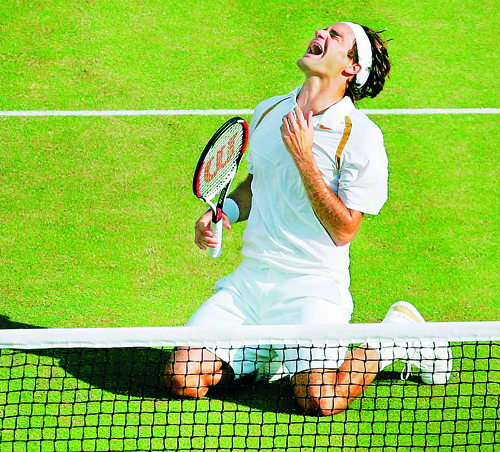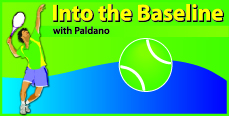Challenging the English Lawns?
Tennis was originally called ‘Lawn-Tennis’. England revived Tennis in the middle of 1800s and played on lawns, hence the name. Traditionally in June, after the French-Open on the clay courts of Paris, world ranked players went to England to prepare for the Wimbledon championships on the grass courts. Some years ago only England had grass court events. The Queen’s and East Bourne events were considered the traditional warm up events for the Wimbledon. This has changed.

Roger Federer at Wimbledon
In recent times it seems like players prefer grass courts of Halle in Germany for men and Hertogenbosch in Holland for women than the traditional English events. The event in Halle is in the same week as the traditional Queen’s in London for men. In most of the countries, Tennis is played on Synthetic hard courts and on loose Clay. In the former English colonies there were grass courts too. From what I know, Colombo’s Queen’s Club had two grass courts. Major events on grass courts were only in England, Australia and the USA but only England kept the grass throughout.
Grass court game
The surface challenges the player, before the opponent does. It affects all aspects of the game. Tactics must suit the surface to win. Nadal, a former Wimbledon winner, fresh from his French-Open title on clay in Paris two weeks ago was eliminated in the second round by a relatively unknown player on grass in Halle. He simply did not adapt to the challenge of grass. Fading Federer whose style and game is versatile, adapted well and won the title in Halle.
Few specialties are necessary to do well on grass courts. Good first flat serve is extremely rewarding on grass. This is due to speed. Speed of a shot is measured when the ball crosses the net. Technically it relates to the speed at which the ball leaves the racquet of a player. The flat serve bounce on the grass courts does not reduce speed if at all, it is marginal. [Clay would take away anything up to 50% of the speed and synthetic surfaces much less] This means to play on grass, players will have to shorten their stroke to accommodate speed. This creates ball control issues. Any spin on grass will be enhanced as the ball would grip the grass very hard. All these makes the toughest shot for on grass, the ‘return-of-serve’. Due to this most of the points finish in the service-situation. It also makes the rallies short. Passing a person at net is also difficult on grass as players approach the net with ‘slice’ [under-spin]. Under-spin keeps the ball very low on grass. The most advantages position to play is the net on grass provided the player has good reaction. The ‘serve-and-volley’ and ‘chip-and-charge’ evolved on grass for these reasons.
Wimbledon grass
Original grass courts were regular grass and permitted only short rallies. This resulted in loss of spectator appeal for the game. Wimbledon changed this and went to the extent of developing a special type of natural grass to withstand two weeks of play without deterioration and to slow down the ball more. They were very successful and now there are longer rallies. In all probabilities, Andy Murray and Rafael Nadal winning Wimbledon could be due to this. They are baseline counter punchers. One could say if not for the Wimbledon championships, grass would have been forgotten. Now the grass surface is being revived. There will not be any other tournaments during the two Wimbledon weeks either. There are two reasons for it. First is Wimbledon being one of the four Grand-Slams and second, the huge prize money on offer.
 Grass courters
Grass courters
All court players like Pete Sampras and Roger Federer have better record on grass than baseliners. Only exception was Steffi Graf of Germany. In the present set of new comers among men are Poland’s Janowicz, Bulgarian Dimitrov and Canada’s Raonic are bound to be impressive this year. I am sure there will be some dark horses in the draw. On the whole this year women’s Tennis has been very exciting to watch. Russia’s Maria Sharapova, Romanian Simona Halep, Spain’s Garbine Muguruza, Canada’s Eugenie Bouchard some Germans, French, Chinese, Poles has left a hot trail up to the French-Open 2014. China’s Li-Na and Serena Williams, Agnieska Radwanska performed enough in 2014 not to be ignored. Women’s Tennis which is very much baseline oriented. Martina Navratilova was the last of the women to be successful using the serve and volley game. Sharapova uses the ‘drive-volley’ well instead of the volley. It is common among women players.
Grass season in the annual Tennis calendar is very short. At the most a player will play four grass events a year. Overall a player could be playing up to 25 tournaments a year. As a result only a few have a good Grass court game. Cost of maintaining grass courts could be one of the reasons behind fewer grass court events. In clubs, grass courts get to be used only for a few days in a week by members.
The ‘super’ setup of the Wimbledon venue is a dream of many nations. The venue apart from staging the biggest Tennis event in the global calendar, it is also a tourist attraction round the year. This year’s Soccer World Cup in Brazil along with Wimbledon will make the months of June and July ‘dream-time’ for sports enthusiasts.
-George Paldano, former international player; Accredited Coach of Germany, ITF and USPTR; National, Davis Cup and Federation Cup Coach–gptennis.ceylon@gmail.com-


